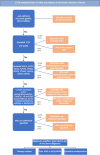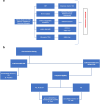How to improve AML outcomes?
- PMID: 39621189
- PMCID: PMC11612101
- DOI: 10.1007/s44313-024-00041-7
How to improve AML outcomes?
Abstract
Understanding the intricacies of the pathophysiology and genomic landscape has enhanced the long-term outcomes for patients with acute myeloid leukemia (AML). The identification of novel molecular targets has introduced new therapeutic strategies that attempt to surpass the dominance of the "7 + 3 regimen" established in the 1970s. In 2022, the World Health Organization and International Consensus Classification revised their definitions and approaches to AML, reflecting the current and evolving changes at the molecular level. The guidelines are now grounded in a definition of the disease that emphasizes genetic characteristics. Today, we recognize AML as a genetically diverse disease; a retrospective study identified 5234 driver mutations across 76 genes or genomic regions, with two or more drivers observed in 86% of patients (Papaemmanuil et al., N Engl J Med 374:2209-21, 2016).
Keywords: AML; Mutations; Outcome; Relapsed; Targeted; Treatment.
© 2024. The Author(s).
Conflict of interest statement
Declarations. Ethics approval and consent to participate: Not applicable. Competing interests: The authors declare no competing interests.
Figures



References
-
- Estey E, et al. Effect of diagnosis (refractory anemia with excess blasts, refractory anemia with excess blasts in transformation, or acute myeloid leukemia [AML]) on outcome of AML-type chemotherapy, The Journal of the American Society of Hematology. Blood. 1997;90(8):2969–77. - PubMed
-
- DiNardo CD, Garcia-Manero G, Kantarjian HM. Time to blur the blast boundaries. Cancer, Wiley Online Library. 2022;128(8):1568–70. - PubMed
-
- Döhner H, et al. Diagnosis and management of AML in adults: 2022 recommendations from an international expert panel on behalf of the ELN, The Journal of the American Society of Hematology. Blood. 2022;140(12):1345–77. - PubMed
Publication types
LinkOut - more resources
Full Text Sources

